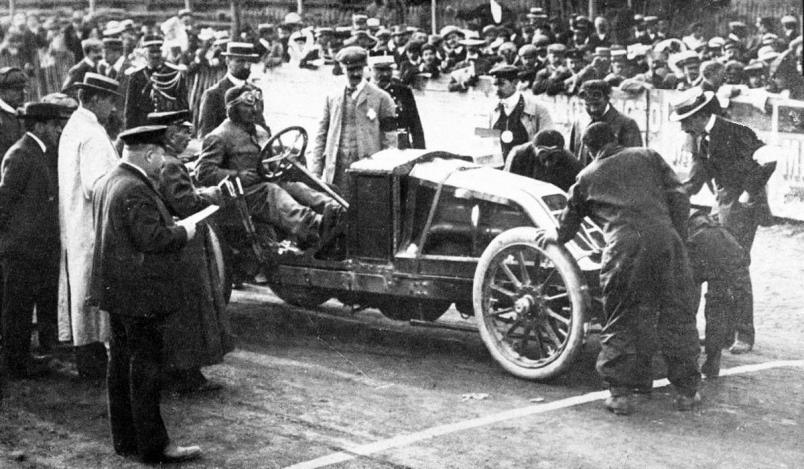 Ferenc Szisz on the first day of the ACF 1906 Grand Prix at the start in Pont de Gennes
Ferenc Szisz on the first day of the ACF 1906 Grand Prix at the start in Pont de Gennes
The First Grand Prix
20 February, 2025
The First Grand Prix 1906 Le Mans, France
Before World War I, there was only one Grand Prix: the French Grand Prix.
While France embraced racing on public roads, albeit fragile ones, that posed hazardous threats to racing drivers, the UK maintained strict speed limits. The Locomotives Act of 1865 (known as "the red flag act") restricted speeds to 4 mph in the countryside and 2 mph in towns, requiring a walker to precede vehicles. This act remained in force until its repeal in 1896.
The UK wouldn't establish its own Grand Prix until 1926, though it did host the Tourist Trophy on open roads on the Isle of Man.
Le Mans was already familiar with racing long before it came to host the most prestigious race in the world in 1923.
Le Mans hosted the first French Grand Prix on June 26-27, 1906.
The Grand Prix consisted of 12 laps on a 103 km course, covering a total distance of 1,238 km.
Ferenc Szisz, driving for Renault, won with an average speed of 102 km/h (63 mph), reaching speeds of up to 145 km/h (90 mph) on the straights. Fiat secured second place.
Place Your Bets
Notably he wasn't the bookies favourite who had 8 - 1 odds on Hemery (Darracq) and Baras (Brasier) and Vincenzo Lancia n his Fiat at 10-to-1.
Szisz's victory with odds of 200 - 1 must have hurt!
Early Automotive Innovation
German engineers at Daimler and Benz led the way in engine development, but it was the French who embraced these innovations and pioneered motor racing. In 1890, Panhard and Levassor acquired the rights to manufacture Daimler engines, and they extended these rights to Peugeot for use in self-propelled vehicles. Benz even stored his car in Panhard and Levassor's workshop.
In 1891, Panhard developed what became known as the "Panhard System"—a four-wheel car with a front-mounted engine, rear-wheel drive, and sliding gear transmission. This design remained the industry standard for nearly 40 years.
Benz achieved early success when his Paris agent, Emile Roger, managed to sell several Benz cars in the French market.
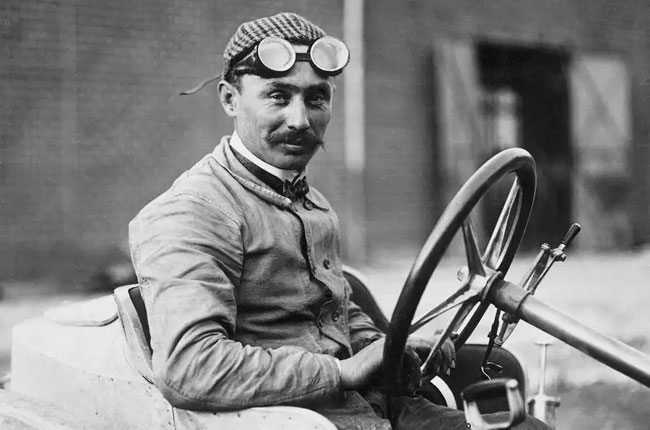
Ferenc Szisz won the first Grand Prix in 1906 driving 12 laps in a Renault in a time of 12 hrs, 14 mins and 7.4 seconds.
Notable Racing "Firsts"
1900: First of the Gordon Bennett series: Paris - Lyon
1901: Second Gordon Bennett race Paris - Bordeaux
1902: First Circuit Des Ardennes Race - Belgium
1902: Third Gordon Bennett race -Paris Innsbruck, Austria
1903: Fourth Gordon Bennett race - Ireland
1904: Fifth Gordon Bennett race Homburg, Germany
1905: Sixth & final Gordon Bennett race - Auvergne, France
1905: First RAC Tourist Trophy - Isle of Man
1906: First French Grand Prix at Le Mans
1906: First Targa Florio Sicily
1907-1912: Dieppe Grand Prix
1907: Kaiser Grand Prix
1913: Amiens Grand Prix
1914: Lyon Grand Prix
1921: Le Mans Grand Prix
1921: First Italian Grand Prix - Montichiari, Sicily
1923: First Le Mans 24 Hour Endurance Race
1926: First British Grand Prix - Brooklands
1926: First German Grand Prix - Berlin
1929: First Monaco Grand Prix
After the war, Le Mans hosted the Grand Prix again in 1921. The winner averaged 125.69 km/h (78.1 mph) over 30 laps, covering 517.86 km (321.78 miles).
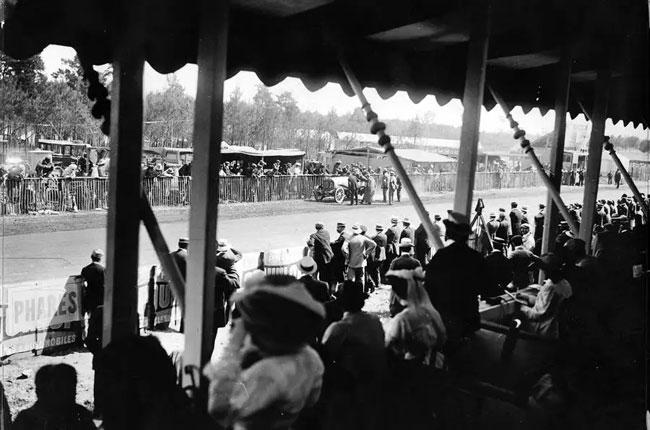
Spectator Stand at the First Grand Prix taking place at Le Mans in 1906
George Heath, who won the first Vanderbilt Cup race in 1904, stops at the pits opposite the spectator stand in his Panhard. He would come sixth in the 1st Grand Prix, some 2 ½ hours after Ferenc Szisz crossed the winning line.
The World's First Car Race
The first organized car trial in France was announced in December 1893 by "Le Petit Journal." Scheduled for July 22, 1894, the Paris-Rouen race offered a first prize of 5,000 francs. Competitors had to complete the 126 km (78 miles) course within eight and a half hours, with total prize money of 10,000 francs.
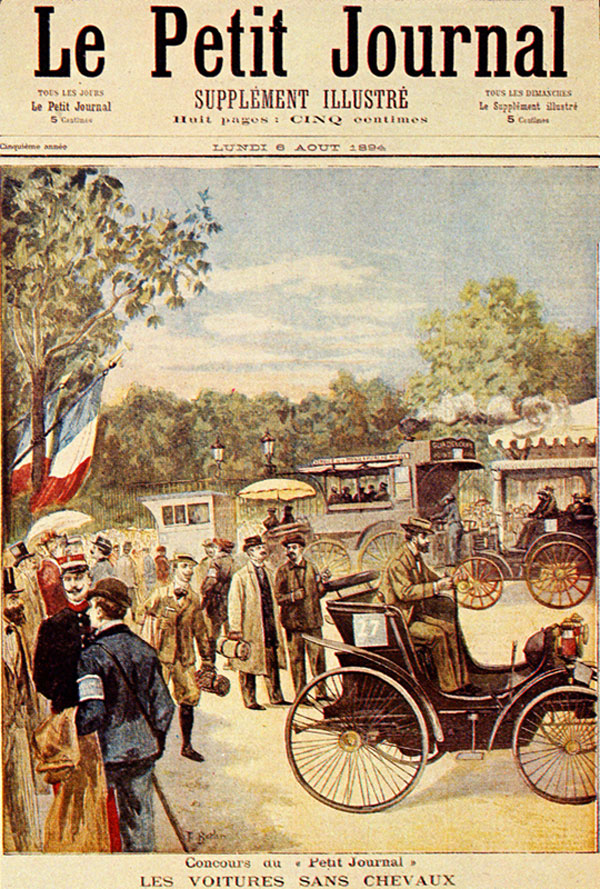
1894 Paris-Rouen Race
50 km pre-qualifying race
The main race was preceded by four days of qualifying events and displays. While 102 participants registered (paying 10 francs each), only 26 appeared on July 18, 1894. To qualify for the main race to Rouen, competitors had to complete a 50 km preliminary race in under three hours. Of the 26 starters, 21 successfully qualified.
The Paris-Rouen competitors included 13 Panhard-Levassors and Peugeots, all powered by Daimler engines, a Benz and 7 steam engines. Three out of seven steam engines completed the journey.
1894 Paris-Rouen Race Rules
The vehicle had to be “not dangerous, easy to drive, and cheap during the journey.” Out of a field of 30, of which nine were steam-powered and two electric, 18 were classed as “finishers.”
Steam Triumphs over Petrol
A De Dion steam engine driven by Jules-Albert de Dion actually arrived first with an average speed of 19 km/h (12 mph). Despite having a better time than the Peugeot that arrived three and a half minutes later, averaging 16 km/h (11 mph), the De Dion was disqualified because steam engines needed both a driver and a stoker.
It was, however, still recognised with the Second prize of 2,000 francs.
First prize was shared between Panhard & Levassor and Peugeot the two manufacturers of the twelve Daimler-powered cars that arrived within the time limit.
- Third prize: 9-seater Serpollet steam engine.
- Fourth prize: (1,000 francs) was shared between two manufacturers, Panhard-Vacheron and Le Brun.
- Fifth Prize: (500 francs) was awarded to Emilé Roger who was driving the Benz.
Europe’s First Motoring Competition
There was a race advertised 6 years earlier in 1887 as “Europe’s first motoring competition,” but Jules-Albert de Dion was the only one who turned up, so that doesn’t count!
1895 1st Motor Race: Paris - Bordeaux - Paris
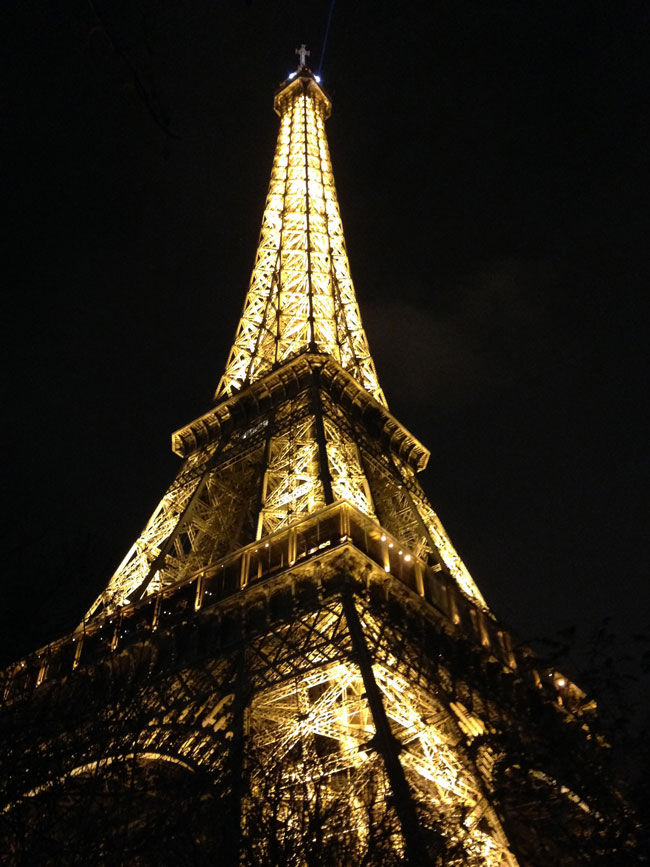
The Eiffel Tower
In fact, racegoers in 1895 never saw the Eiffel Tower as work did not start on it until January 1887. It opened on 6th May 1889 for the World’s Fair.
French engineers René Panhard and Émile Levassor, visiting the World's Fair (6th May - 31st October 1889), saw the Daimler “Steelwheeler” car on display. They would go on to sell their first automobile in 1890, based on a Daimler engine license.
Panhard and Levassor then shared their Daimler engine license with a bicycle maker by the name of Armand Peugeot, who formed a car company.
2012: Volvo acquired Panhard for 62.5 million euros
The 1200 km Paris - Bordeaux - Paris event in 1895, organised by a group of Paris newspaper publishers, is recognised as the first actual motor race in history.
Despite the rules, the Panhard & Levassor vehicle driven by Émile Levassor (which did well in the Paris-Rouen race) completed the 1200 km (732 miles) in 48 hours and 48 minutes but was demoted to 3rd place.
The unsuspecting vehicle that came third with 59 hours and 48 minutes (what's a mere 11 hours?) was given first prize.
The second arrival in 54 hours and 35 minutes was also not eligible for the first prize either as officially **it was a 4 seater car race.**
- 1st Émile Levassor: Panhard & Levassor 48:48:00, 24.54 km/h (Ineligible for First prize – 2 seater)
- 2nd Louis Rigoulot: Peugeot 54:35:00 (also ineligible for the first prize – as it was a 2 seater)
- 3rd Paul Koechlin: Peugeot 59:48:00, 4 seats (The winner!!! and won the first prize)
There was uproar, so much so that the A.C.F. were compelled to be the organisers of the next race.
Notably, one of the two electric cars manufactured by Jeantaud finished the race.
1st Land Speed Record (LSR) set by an Electric Car
18th December 1898
Organised by “La France Automobile” magazine, a Jeantaud electric car set the first land speed record at 63.15 km/h (39.24 mph).
17th January 1899
It broke its own record with 66.65 km/h (41.4 mph).
4th March 1899
And again, achieving a speed of 92 km/h (57 mph).
April 1899
That record was eclipsed by Belgian racing driver Camille Jenatzy, who held the record of 105.88 km/h (65.79 mph).
April 1902
The World Land Speed record of 120.80 km/h (75.06 mph) was achieved by a steam-powered engine by Léon Serpollet, a French engineer.
Michelin Tyres had arrived for cars
On bicycles, at least, Michelin had a booming patented product in the detachable tyre on a metal rim.
L'Éclair was No. 46, a Peugeot-designed car, powered by a boat engine and built by brothers André and Édouard Michelin in 1895 and was the first car in the world to participate in a motor race with pneumatic tyres during the 1895 Paris - Bordeaux - Paris race.
Last Place for the Michelin Brothers
They completed the 1200km journey and despite including regular service points along the road, finished last outside of the time limit having had “Tyre trouble”.
A year later 300 Paris taxis had pneumatic tyres and Michelin would go on to be the largest producer of car tyres in the world, building a plant in Italy in 1906.